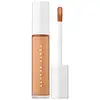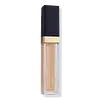Fenty Beauty Pro Filt'r Instant Retouch Concealer Versus Estée Lauder Futurist Soft Touch Brightening Skincealer Concealer
What's inside
What's inside
 Key Ingredients
Key Ingredients

 Benefits
Benefits

 Concerns
Concerns

 Ingredients Side-by-side
Ingredients Side-by-side

Water
Skin ConditioningHydrogenated Didecene
Skin ConditioningHydrogenated Polyisobutene
EmollientDisteardimonium Hectorite
StabilisingTrimethylsiloxysilicate
EmollientCetyl PEG/PPG-10/1 Dimethicone
EmulsifyingGlycerin
HumectantNylon-12
Dimethicone
EmollientMethicone
EmollientSodium Chloride
MaskingAcrylates/Polytrimethylsiloxymethacrylate Copolymer
Skin ConditioningPolymethylsilsesquioxane
Hydrogenated Styrene/Isoprene Copolymer
Hydroxyacetophenone
AntioxidantLauryl PEG-8 Dimethicone
Hdi/Trimethylol Hexyllactone Crosspolymer
1,2-Hexanediol
Skin ConditioningCaprylyl Glycol
EmollientTocopheryl Acetate
AntioxidantTrisodium Ethylenediamine Disuccinate
Talc
AbrasiveLauroyl Lysine
Skin ConditioningCombretum Fruticosum Flower Nectar
MaskingAlcohol
AntimicrobialButylene Glycol
HumectantPentaerythrityl Tetra-Di-T-Butyl Hydroxyhydrocinnamate
AntioxidantCentella Asiatica Leaf Extract
Skin ConditioningCamellia Sinensis Leaf Extract
AntimicrobialTitanium Dioxide
Cosmetic ColorantIron Oxides
Water, Hydrogenated Didecene, Hydrogenated Polyisobutene, Disteardimonium Hectorite, Trimethylsiloxysilicate, Cetyl PEG/PPG-10/1 Dimethicone, Glycerin, Nylon-12, Dimethicone, Methicone, Sodium Chloride, Acrylates/Polytrimethylsiloxymethacrylate Copolymer, Polymethylsilsesquioxane, Hydrogenated Styrene/Isoprene Copolymer, Hydroxyacetophenone, Lauryl PEG-8 Dimethicone, Hdi/Trimethylol Hexyllactone Crosspolymer, 1,2-Hexanediol, Caprylyl Glycol, Tocopheryl Acetate, Trisodium Ethylenediamine Disuccinate, Talc, Lauroyl Lysine, Combretum Fruticosum Flower Nectar, Alcohol, Butylene Glycol, Pentaerythrityl Tetra-Di-T-Butyl Hydroxyhydrocinnamate, Centella Asiatica Leaf Extract, Camellia Sinensis Leaf Extract, Titanium Dioxide, Iron Oxides
Dimethicone
EmollientWater
Skin ConditioningMethyl Trimethicone
Skin ConditioningButylene Glycol
HumectantTrimethylsiloxysilicate
EmollientPhenyl Trimethicone
Skin ConditioningNeopentyl Glycol Diheptanoate
EmollientGlycerin
HumectantPEG-10 Dimethicone
Skin ConditioningTrametes Versicolor Extract
PEG/PPG-18/18 Dimethicone
EmulsifyingAscorbyl Glucoside
AntioxidantDisteardimonium Hectorite
StabilisingDimethicone/PEG-10/15 Crosspolymer
Sodium Hyaluronate
HumectantAcetyl Hexapeptide-8
HumectantAlgae Extract
EmollientCholesterol
EmollientHelianthus Annuus Seed Extract
Skin ConditioningTocopheryl Acetate
AntioxidantSqualane
EmollientHordeum Vulgare Extract
EmollientLaminaria Digitata Extract
Skin ProtectingCucumis Sativus Fruit Extract
EmollientHydrolyzed Yeast Protein
Skin ConditioningHydrolyzed Rice Extract
Skin ConditioningNarcissus Tazetta Bulb Extract
AstringentBHT
AntioxidantTocopherol
AntioxidantLecithin
EmollientTriethoxycaprylylsilane
Disodium Stearoyl Glutamate
CleansingAluminum Dimyristate
Emulsion StabilisingLauryl PEG-9 Polydimethylsiloxyethyl Dimethicone
Skin ConditioningPropylene Carbonate
SolventSodium Chloride
MaskingSodium Hydroxide
BufferingSodium Citrate
BufferingCaprylyl Glycol
EmollientPotassium Sorbate
PreservativeCitric Acid
BufferingSodium Benzoate
MaskingDisodium EDTA
Dipropylene Glycol
HumectantChlorphenesin
AntimicrobialPhenoxyethanol
PreservativeLaureth-7
EmulsifyingCI 77891
Cosmetic ColorantCI 77491
Cosmetic ColorantCI 77492
Cosmetic ColorantCI 77499
Cosmetic ColorantMica
Cosmetic ColorantDimethicone, Water, Methyl Trimethicone, Butylene Glycol, Trimethylsiloxysilicate, Phenyl Trimethicone, Neopentyl Glycol Diheptanoate, Glycerin, PEG-10 Dimethicone, Trametes Versicolor Extract, PEG/PPG-18/18 Dimethicone, Ascorbyl Glucoside, Disteardimonium Hectorite, Dimethicone/PEG-10/15 Crosspolymer, Sodium Hyaluronate, Acetyl Hexapeptide-8, Algae Extract, Cholesterol, Helianthus Annuus Seed Extract, Tocopheryl Acetate, Squalane, Hordeum Vulgare Extract, Laminaria Digitata Extract, Cucumis Sativus Fruit Extract, Hydrolyzed Yeast Protein, Hydrolyzed Rice Extract, Narcissus Tazetta Bulb Extract, BHT, Tocopherol, Lecithin, Triethoxycaprylylsilane, Disodium Stearoyl Glutamate, Aluminum Dimyristate, Lauryl PEG-9 Polydimethylsiloxyethyl Dimethicone, Propylene Carbonate, Sodium Chloride, Sodium Hydroxide, Sodium Citrate, Caprylyl Glycol, Potassium Sorbate, Citric Acid, Sodium Benzoate, Disodium EDTA, Dipropylene Glycol, Chlorphenesin, Phenoxyethanol, Laureth-7, CI 77891, CI 77491, CI 77492, CI 77499, Mica
 Reviews
Reviews

Ingredients Explained
These ingredients are found in both products.
Ingredients higher up in an ingredient list are typically present in a larger amount.
Butylene Glycol (or BG) is used within cosmetic products for a few different reasons:
Overall, Butylene Glycol is a safe and well-rounded ingredient that works well with other ingredients.
Though this ingredient works well with most skin types, some people with sensitive skin may experience a reaction such as allergic rashes, closed comedones, or itchiness.
Learn more about Butylene GlycolCaprylyl Glycol is a humectant and emollient, meaning it attracts and preserves moisture.
It is a common ingredient in many products, especially those designed to hydrate skin. The primary benefits are retaining moisture, skin softening, and promoting a healthy skin barrier.
Though Caprylyl Glycol is an alcohol derived from fatty acids, it is not the kind that can dry out skin.
This ingredient is also used as a preservative to extend the life of products. It has slight antimicrobial properties.
Learn more about Caprylyl GlycolDimethicone is a type of synthetic silicone created from natural materials such as quartz.
What it does:
Dimethicone comes in different viscosities:
Depending on the viscosity, dimethicone has different properties.
Ingredients lists don't always show which type is used, so we recommend reaching out to the brand if you have questions about the viscosity.
This ingredient is unlikely to cause irritation because it does not get absorbed into skin. However, people with silicone allergies should be careful about using this ingredient.
Note: Dimethicone may contribute to pilling. This is because it is not oil or water soluble, so pilling may occur when layered with products. When mixed with heavy oils in a formula, the outcome is also quite greasy.
Learn more about DimethiconeDisteardimonium Hectorite comes from the clay mineral named hectorite. It is used to add thickness to a product.
It can also help stabilize a product by helping to disperse other ingredients.
Hectorite is a rare, white clay mineral.
Learn more about Disteardimonium HectoriteGlycerin is already naturally found in your skin. It helps moisturize and protect your skin.
A study from 2016 found glycerin to be more effective as a humectant than AHAs and hyaluronic acid.
As a humectant, it helps the skin stay hydrated by pulling moisture to your skin. The low molecular weight of glycerin allows it to pull moisture into the deeper layers of your skin.
Hydrated skin improves your skin barrier; Your skin barrier helps protect against irritants and bacteria.
Glycerin has also been found to have antimicrobial and antiviral properties. Due to these properties, glycerin is often used in wound and burn treatments.
In cosmetics, glycerin is usually derived from plants such as soybean or palm. However, it can also be sourced from animals, such as tallow or animal fat.
This ingredient is organic, colorless, odorless, and non-toxic.
Glycerin is the name for this ingredient in American English. British English uses Glycerol/Glycerine.
Learn more about GlycerinChances are, you eat sodium chloride every day. Sodium Chloride is also known as table salt.
This ingredient has many purposes in skincare: thickener, emulsifier, and exfoliator.
You'll most likely find this ingredient in cleansers where it is used to create a gel-like texture. As an emulsifier, it also prevents ingredients from separating.
There is much debate on whether this ingredient is comedogenic. The short answer - comedogenic ratings don't tell the whole story. Learn more about comegodenic ratings here.
The concensus about this ingredient causing acne seems to be divided. Research is needed to understand if this ingredient does cause acne.
Scrubs may use salt as the primary exfoliating ingredient.
Learn more about Sodium ChlorideTocopheryl Acetate is AKA Vitamin E. It is an antioxidant and protects your skin from free radicals. Free radicals damage the skin by breaking down collagen.
One study found using Tocopheryl Acetate with Vitamin C decreased the number of sunburned cells.
Tocopheryl Acetate is commonly found in both skincare and dietary supplements.
Learn more about Tocopheryl AcetateThis silicone is an emollient. Emollients create a thin film on the skin to prevent moisture from escaping.
It is not soluble in water and helps increase water-resistance in products.
According to a manufacturer, it can blend seamlessly with silicone oils, such as Cyclopentasiloxane.
Learn more about TrimethylsiloxysilicateWater. It's the most common cosmetic ingredient of all. You'll usually see it at the top of ingredient lists, meaning that it makes up the largest part of the product.
So why is it so popular? Water most often acts as a solvent - this means that it helps dissolve other ingredients into the formulation.
You'll also recognize water as that liquid we all need to stay alive. If you see this, drink a glass of water. Stay hydrated!
Learn more about Water